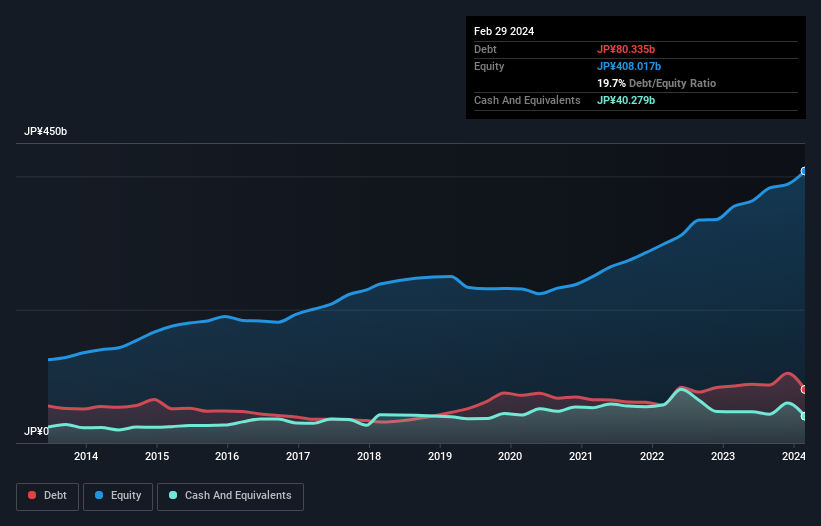Here's Why YASKAWA Electric (TSE:6506) Can Manage Its Debt Responsibly

Warren Buffett famously said, 'Volatility is far from synonymous with risk.' So it might be obvious that you need to consider debt, when you think about how risky any given stock is, because too much debt can sink a company. We note that YASKAWA Electric Corporation (TSE:6506) does have debt on its balance sheet. But the more important question is: how much risk is that debt creating?
When Is Debt Dangerous?
Debt assists a business until the business has trouble paying it off, either with new capital or with free cash flow. If things get really bad, the lenders can take control of the business. However, a more common (but still painful) scenario is that it has to raise new equity capital at a low price, thus permanently diluting shareholders. Of course, plenty of companies use debt to fund growth, without any negative consequences. When we examine debt levels, we first consider both cash and debt levels, together.
View our latest analysis for YASKAWA Electric
What Is YASKAWA Electric's Net Debt?
The image below, which you can click on for greater detail, shows that YASKAWA Electric had debt of JP¥80.3b at the end of February 2024, a reduction from JP¥85.5b over a year. However, it does have JP¥40.3b in cash offsetting this, leading to net debt of about JP¥40.1b.

How Healthy Is YASKAWA Electric's Balance Sheet?
The latest balance sheet data shows that YASKAWA Electric had liabilities of JP¥189.1b due within a year, and liabilities of JP¥105.2b falling due after that. Offsetting these obligations, it had cash of JP¥40.3b as well as receivables valued at JP¥167.9b due within 12 months. So its liabilities total JP¥86.1b more than the combination of its cash and short-term receivables.
Given YASKAWA Electric has a humongous market capitalization of JP¥1.68t, it's hard to believe these liabilities pose much threat. But there are sufficient liabilities that we would certainly recommend shareholders continue to monitor the balance sheet, going forward.
We measure a company's debt load relative to its earnings power by looking at its net debt divided by its earnings before interest, tax, depreciation, and amortization (EBITDA) and by calculating how easily its earnings before interest and tax (EBIT) cover its interest expense (interest cover). This way, we consider both the absolute quantum of the debt, as well as the interest rates paid on it.
YASKAWA Electric has a low net debt to EBITDA ratio of only 0.46. And its EBIT easily covers its interest expense, being 41.3 times the size. So you could argue it is no more threatened by its debt than an elephant is by a mouse. Fortunately, YASKAWA Electric grew its EBIT by 4.3% in the last year, making that debt load look even more manageable. When analysing debt levels, the balance sheet is the obvious place to start. But it is future earnings, more than anything, that will determine YASKAWA Electric's ability to maintain a healthy balance sheet going forward. So if you're focused on the future you can check out this free report showing analyst profit forecasts.
Finally, a business needs free cash flow to pay off debt; accounting profits just don't cut it. So we always check how much of that EBIT is translated into free cash flow. In the last three years, YASKAWA Electric created free cash flow amounting to 13% of its EBIT, an uninspiring performance. That limp level of cash conversion undermines its ability to manage and pay down debt.
Our View
YASKAWA Electric's interest cover suggests it can handle its debt as easily as Cristiano Ronaldo could score a goal against an under 14's goalkeeper. But, on a more sombre note, we are a little concerned by its conversion of EBIT to free cash flow. All these things considered, it appears that YASKAWA Electric can comfortably handle its current debt levels. On the plus side, this leverage can boost shareholder returns, but the potential downside is more risk of loss, so it's worth monitoring the balance sheet. Over time, share prices tend to follow earnings per share, so if you're interested in YASKAWA Electric, you may well want to click here to check an interactive graph of its earnings per share history.
Of course, if you're the type of investor who prefers buying stocks without the burden of debt, then don't hesitate to discover our exclusive list of net cash growth stocks, today.
New: Manage All Your Stock Portfolios in One Place
We've created the ultimate portfolio companion for stock investors, and it's free.
• Connect an unlimited number of Portfolios and see your total in one currency
• Be alerted to new Warning Signs or Risks via email or mobile
• Track the Fair Value of your stocks
Have feedback on this article? Concerned about the content? Get in touch with us directly. Alternatively, email editorial-team (at) simplywallst.com.
This article by Simply Wall St is general in nature. We provide commentary based on historical data and analyst forecasts only using an unbiased methodology and our articles are not intended to be financial advice. It does not constitute a recommendation to buy or sell any stock, and does not take account of your objectives, or your financial situation. We aim to bring you long-term focused analysis driven by fundamental data. Note that our analysis may not factor in the latest price-sensitive company announcements or qualitative material. Simply Wall St has no position in any stocks mentioned.
About TSE:6506
YASKAWA Electric
Engages in motion control, robotics, system engineering, and other businesses worldwide.
Flawless balance sheet slight.
Similar Companies
Market Insights
Community Narratives




